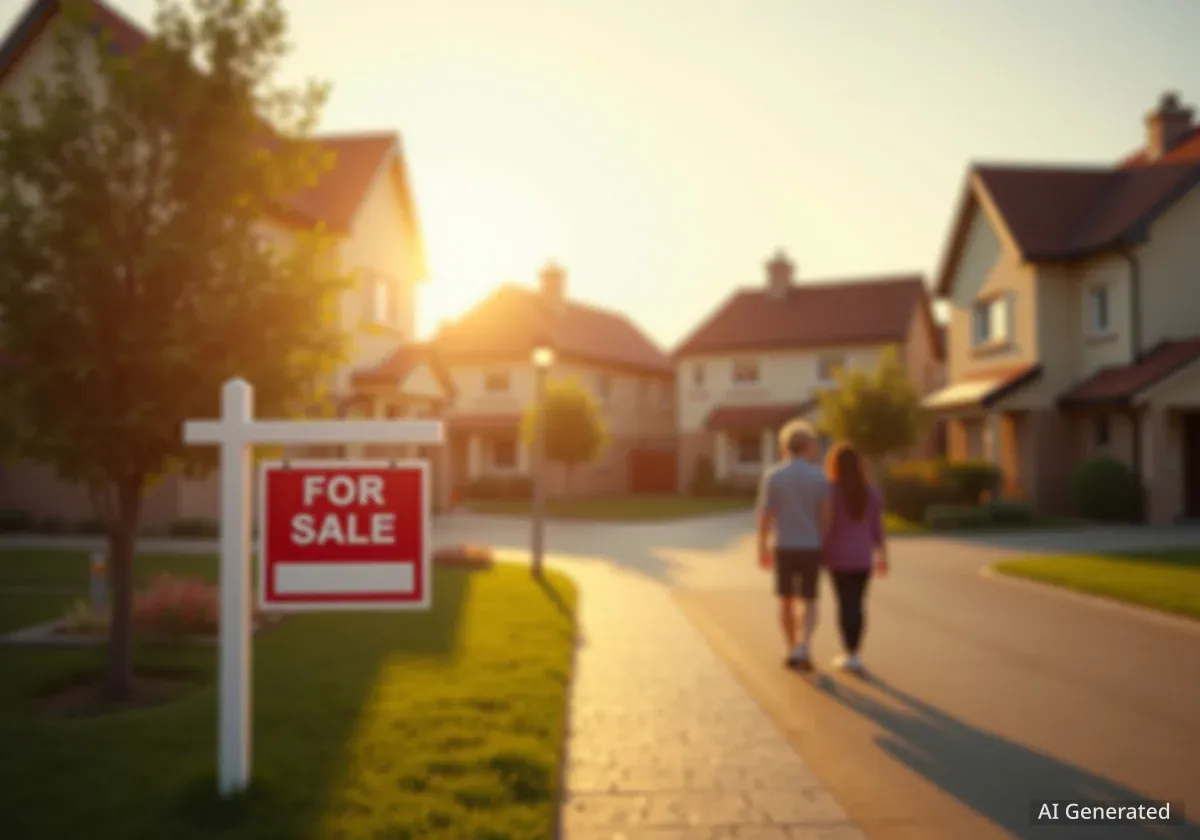The U.S. real estate market is poised for a period of stabilization in 2026, according to multiple industry forecasts. After years of dramatic fluctuations, experts predict a shift away from extremes, with neither a significant boom nor a widespread crash on the horizon. Instead, the market is expected to experience modest price growth and a gradual increase in sales activity.
This anticipated stability is largely dependent on the direction of mortgage interest rates, which are projected to ease throughout the year. For buyers, sellers, and investors, this outlook suggests a more predictable, though still competitive, landscape compared to the volatility of the early 2020s.
Key Takeaways
- Modest Price Growth: National home prices are expected to increase slightly, with forecasts ranging from 0.4% to 3.6%.
- Increased Sales Volume: Projections indicate a significant rise in home sales, potentially increasing by over 10% as affordability improves.
- Falling Mortgage Rates: A key driver for the market, 30-year fixed mortgage rates are forecast to drop, possibly falling below 6% by the end of 2026.
- Regional Differences: Market performance will vary significantly by location, with some areas seeing stronger growth while others may face minor declines.
- Inventory Improvement: The number of homes for sale is expected to gradually increase, driven by new construction and demographic shifts.
The Path to a More Balanced Market
To understand the projections for 2026, it is essential to review the recent history of the housing market. The period following the pandemic was marked by unprecedented conditions. Extremely low interest rates and a surge in remote work fueled a buying frenzy that pushed national home prices up by over 40% in just a few years.
However, this rapid growth was not sustainable. In response to rising inflation, the Federal Reserve implemented a series of interest rate hikes. This action caused mortgage rates to climb, significantly increasing the cost of homeownership and cooling demand. Many existing homeowners, who had secured mortgages with rates around 3%, became reluctant to sell and take on new loans at much higher rates, a phenomenon known as the "locked-in" effect.
Context: The 2025 Market Slowdown
As of late 2025, the market remains in a state of adjustment. Mortgage rates are hovering between 6.5% and 6.7%, creating affordability challenges for many potential buyers. This has led to relatively flat home price growth and slower sales activity. A nationwide shortage of approximately 4.5 million homes continues to keep prices from falling, setting the stage for the anticipated recovery in 2026.
Unlike the 2008 financial crisis, which was driven by subprime lending and widespread foreclosures, the current market is built on a stronger foundation. Lending standards are now much stricter, reducing the risk of a similar collapse.
Home Price Projections for 2026
The consensus among real estate analysts is that 2026 will bring a gentle rise in home prices, not a sharp spike. Different organizations offer slightly varied forecasts, but all point toward modest, single-digit growth at the national level.
Zillow, a leading real estate data firm, projects a conservative 0.4% increase in national home values from mid-2025 to mid-2026. This indicates a market that is stabilizing rather than accelerating.
Fannie Mae presents a more optimistic view, forecasting a 3.6% growth in home prices for the year. The National Association of Realtors (NAR) aligns with this trend, predicting that the median home price will reach approximately $420,000, representing a 2% increase.
Varying Forecasts for 2026
- Zillow: +0.4%
- Fannie Mae: +3.6%
- National Association of Realtors (NAR): +2.0%
Real Estate Is a Local Story
It is crucial to remember that national averages do not reflect the conditions in every local market. Economic health, job growth, and housing supply will create significant regional variations in 2026.
- Potential Growth Areas: Markets in the Northeast and Midwest are expected to perform well. For example, Atlantic City, New Jersey, could see price increases of up to 4.3%, while Saginaw, Michigan, is projected to grow by 3.8%. These areas often combine affordability with stable job markets.
- Markets Facing Declines: Conversely, some regions may experience price drops. In Louisiana, cities like Houma and New Orleans could see declines between 5% and 8% due to local economic challenges and supply-demand imbalances.
- Major State Outlooks: California is expected to see its median price climb by 3.6%. Florida is projected to continue its strong performance with growth between 3% and 5%, driven by population influx and sustained investor interest.
Sales and Inventory: A Shift Toward More Activity
One of the most significant changes expected in 2026 is a rebound in the number of homes being sold. As mortgage rates decline, more buyers are expected to enter the market, boosting sales volume.
The NAR forecasts that sales of existing homes will jump by 11% to 13%, while new-home sales could rise by 5% to 8%. Similarly, Fannie Mae predicts an overall sales increase of nearly 10%, contingent on mortgage rates falling below the 6% threshold.
"A decline in mortgage rates is the key factor that could unlock both buyer demand and seller activity, leading to a more fluid market in 2026."
The long-standing issue of low inventory may also begin to ease. A major demographic shift is underway as millions of Baby Boomers consider downsizing their homes. This trend could release a substantial number of properties onto the market over the next decade, with the initial effects becoming more visible around 2026. Experts estimate that up to 14.6 million homes could be listed by this generation by 2036.
New construction will also contribute to supply, with an estimated 1.05 million new single-family homes expected to be built in 2026. This combination of existing and new inventory could create more options for buyers and potentially lead to a more balanced market by the middle of the year.
Economic Factors Shaping the Outlook
The housing market's performance is closely tied to the health of the broader economy. For 2026, economic forecasts suggest a stable environment conducive to a healthy real estate market.
The U.S. economy is projected to grow at a steady rate of 2.0% to 2.2%, according to sources like Deloitte and the Congressional Budget Office. The unemployment rate is expected to remain low, holding between 4.3% and 4.6%, which supports consumer confidence and the ability to make large financial commitments like buying a home.
Interest Rates Remain the Dominant Factor
The single most important variable for the 2026 housing market will be interest rates. After peaking in previous years, the trend is expected to reverse. Fannie Mae forecasts that the average 30-year fixed mortgage rate could fall to 5.9% by the end of 2026. A drop of this magnitude would significantly improve affordability, lowering monthly payments and enabling more households to qualify for loans.
Key Economic Projections for 2026
- GDP Growth: 2.0% - 2.2%
- Unemployment Rate: 4.3% - 4.6%
- Projected Mortgage Rate (End of Year): 5.9%
Potential Risks to Monitor
While the outlook is generally positive, several factors could disrupt the trend toward stability. Renewed inflation could force the Federal Reserve to maintain higher interest rates for longer, slowing the market's recovery. In certain regions, such as Florida and California, rising home insurance costs related to climate events could also dampen demand. Finally, global economic instability or stock market volatility could make consumers more cautious about large investments.
Despite these risks, the strong underlying fundamentals of the current market—including strict lending standards and low unemployment—make a widespread crash highly unlikely. The prevailing expert consensus points toward a year of normalization and measured recovery for the U.S. housing market.





